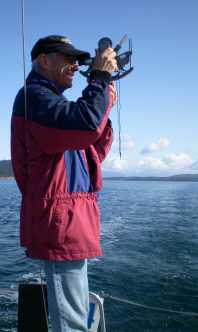Celestial Navigation reached the pinnacle of perfection over 130 years ago as a result two important developments: accurate instruments - a reliable marine chronometer and an accurate sextant and the publication of nautical almanacs and sight reduction tables. From the early nineteenth century until the last two decades of the twentieth century mariners relied on celestial navigation as their primary means of determining their position at sea. Using a sextant and performing sight reductions was a part of the daily routine for every junior deck officer.
The process of obtaining a celestial fix became as automatic, and as easy, as tying one’s shoes or riding a bicycle. Experts could plot their positions to within a quarter mile, and accuracy of within one mile was considered adequate. The development of reliable electronic navigation tools, and DGPS in particular, relegate celestial navigation to the status of a nostalgic, nearly useless, craft. With GPS accuracies measured in increments of a few feet, it is easy to see why celestial navigation is no longer practiced. In fact, one of the most critical elements of celestial navigation, knowing the chronometer error, is now checked against the GPS more often than against broadcast time tick. As a result, deck officer celestial navigation skills deteriorate, and unlicensed deckhands have an ever-diminishing opportunity to observe the process. Like learning to tie one’s shoes or ride a bicycle, trying to tell someone how to do it is more difficult than showing them.
Prior to the 1980s nearly every curious helmsman had the opportunity to observe the junior deck officers take celestial sights and reduce them. They could overhear senior deck officers pass on tips for honing techniques, and lucky ones could ask questions and try own hands at it. With those opportunities disappearing, now you have to rely on places like this to learn.
I was one of those junior deck officers aboard the Coast Guard Cutter TAMAROA in the early 1980s. I often stood the 4 to 8 watches, so I was on watch at both morning and evening nautical twilight and, therefore, responsible for taking the morning and evening star shots each day we had clear skies. I also had the opportunity to teach a fair number of curious sailor the methods. Yet, twenty-five years later, when I needed to pass the Coast Guard Celestial Navigation exam for the oceans endorsements on my license, I had to re-learn nearly everything.
I created Celestial Navigation Inside Out (CNIO) for those mariners who need it for either a U. S. Coast Guard license exam or as preparation for the STCW95 Celestial Navigation course. With that in mind CNIO focuses on utilizing the resources you will have available in the USCG examination room. All examples come either from one of those resources (so you can refer back to them during the exam) or actual USCG exam questions. As you struggle to work through periods of frustration and uncertainty, remember that your goal should be to reach a level of comfortable proficiency not perfection. Achieving that will make celestial navigation as natural as tying your shoe or riding a bicycle.
The references below will help you through the learning process. The links open new windows. The 1981 Nautical Almanac used for all Coast Guard exam problems is available online from various sources (here is the Coast Guard National Maritime Center version. The Sight Reduction tables (H.O.229) and the entire contents of the new single-volume edition of Bowditch's American Practical Navigator is available from the publications page of the National Geospacial-intelligence Agency web site at: NGA Marine Safety Information Portral Select 'Publications' from the left menu then you choose which publication from the drop down menu at the top of the publications page. Several other helpful publications are available from this site as well. More information about what is available in the exam room is at The US Coast Guard National Maritime Center site here (it opens in a new window as a PDF with links).
